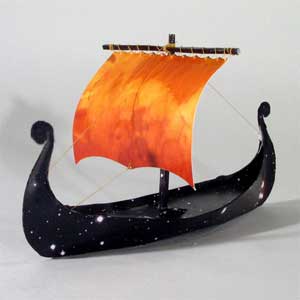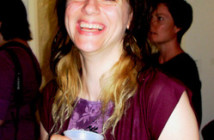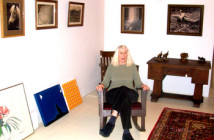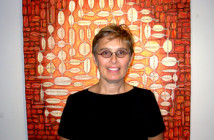Yeah right. Try to find a parking space during the jam packed First Friday festivities in the lively, newly expanded, gorgeously renovated and upgraded South End of Boston. Thanks be to Saint Christopher, the patron saint of agnostic travelers, we lucked out and found an empty space. Just steps from our destination.
It was a lovely night indeed as every conceivable Boston artist, past, present and future was out and about. Perhaps, including some smart collectors with deep pockets. But I have never been good at spotting them. They like to avoid crowds and remain anonymous. There were a few gallerists from posh Newbury Street like Howard Yezerski strolling along with his wife Katherine. Likewise, Arthur Dion and co-director, Meg Wilson, with their rising art star, Reese Inman, in orbit. The quippery was fast and furious.
As a social occasion it was just grand. Great to see such critical mass and enthusiasm. There was a touch of marketing genius as Samson Projects had a bar set up pouring martinis for the masses in fancy goblets courtesy of Noilly and Pratt. It was tres sophistique compared to the usual three for ten rotgut in most other spaces. Some cheapo galleries ran dry after their three allotted bottles and pound of cheddar cheese cut up into tiny cubes. One gallery, touting its grand opening, was serving sparkling cider. Which any way you cut it ain’t champagne. Everyone, but everyone, seemed to love the Noilly Pratt cocktails. But the gallerist of Samson Projects apparently was schmoozing that night with Delilah in Miami at the art fair. Some people like to play Marcel Proust, it seems, by throwing great parties they decline to attend because they are off celebrating even better parties.
In a recent review in Big Red and Shiny, my learned colleague, Matthew Nash, mused whether it was kosher to write about an exhibition, the case in point Art Interactive in Cambridge, based on attending an opening. Yes Matt, by all means. It can feel very sober and different the next day, after all the fun, when the gallery is virtually empty. Perhaps one has a more clear headed assessment. But we miss the cool ambiance. By the way, just for the record, I was in the minority by not indulging in one of those Noilly Pratt martinis however scrumptious and dishy they looked. Yes Matt, it is more fun to view art with a crowd. Be aware though that during openings artists love to ask and tell critics what they think of the works on view.
Matt this issue reminds me of an unfortunate time when I was a freelance movie critic. The upside is that I had lunch with Martin Sheen at the Ritz, just after the opening of Apocalypse Now, and brawled with John Belushi at the Plaza in New York. The downside is that movie critics see films at 9 am in tiny theaters with a few other scribes. No audience reactions to go by. As they say, there is no cheering in the press box. Initially, it seemed great to get into movies free. But the truth is that you had to sit through them. Question? Would you really like to see all dozen movies currently at the local megaplex? Answer. Pity the poor movie critic.
Not that it is really any better for art critics. The vast majority of shows we see just suck. Big time. Like the critic for Art Net, Charlie Finch, the editor of Coagulated says, “Most art sucks.” For the most part I agree with that. But it is better to be an art critic than a movie critic. It takes just seconds to see and walk out of a bad exhibition. Where film and theatre critics have to sit through the entire performance. Yeah, film writers enjoy super perks but they have to put up with more crap. Nobody takes art critics to lunch.
Matthew Ritchie: The Two Way Shot
Mario Diacono at Ars Libri
500 Harrison Avenue
Through December 31
The miracle of the Boston art world is that Mario Diacono continues to show single works or small samples of the most significant artists of our time. It is a remarkable accomplishment. Perhaps the success of his singular program is the commitment he brings to it. Truly, he is one of the few gallerists on any continent who genuinely has something to say about the works he presents.
Every work shown by Diacono over a great span of years has been an amazing aesthetic, philosophical and poetic dialogue with individual artists. The text that he produces, handouts in the gallery and great collectables, are his contribution to the artists. The works he presents and their accompanying texts are often daunting.
But this time, remarkably, I find Mario’s essay providing access to Matthew Ritchie that has previously evaded me. There is a large installation of the work on view at Mass MoCA in North Adams. During the opening, which the artist attended some months ago, Laura Heon, the curator, expressed to visitors that, “He is my compass.” Interesting, since, after numerous visits to the exhibition, and considerable visual and mental gymnastics, I still feel lost and disoriented. While the works, particularly the paintings, are lush and visually attractive, I have been reluctant to enter into the cult of the artist’s esoteric cosmology. The art of the game. Key to its understanding but lost on one who doesn’t play games. Never have. I have absolutely no ability to succeed in or abide by any contest that involves someone else’s rules. Call me Maverick.
With clarity and brilliance Diacono delves into Ritchie’s gamesmanship. Mario revels in discussion of the Tarot with its layers of the occult. It is as close as I will ever come to appreciating Ritchie’s work.
For me, this wasn’t always the case. There was a younger time, while cavorting about the fourth dimension, when I often threw the I Ching to determine hexagrams predicting life decisions. I read the Egyptian and Tibetan books of the dead and all of Herman Hesse including “Magister Ludi.” Worked in the Department of Egyptian Art of the Museum of Fine Arts where I was the keeper of its mummies. Then just stopped. Cold turkey. Said goodbye to Madam Blavatsky and became deeply committed to reality. Such as it is. So Matthew Ritchie is somewhere I don’t want to be. Although I respect the work. As I continue to admire and present as a curator the great Visionary artists of our time including Paul Laffoley and Alex Gray. I just don’t claim to understand them.
Paper.Scissors.Sculpture
Boston Sculptors Group Show
486 Harrison Avenue
Through December 24
After a hiatus, buildout and relocation from its original location in a chapel in West Newton, Boston Sculptors, an artists’ cooperative gallery, founded in 1992, has opened in a magnificent, large, storefront space. There was concern that the group would loose the impact of its original, vaulted, ecclesiastical venue. Which was phenomenal but remotely located. One had to make a pilgrimage to the shrine. Which I did only on the occasion of the last show in that space. It featured work by Joyce McDaniel one of the founders of the organization, who has opted out of continuing. So attending that last exhibition was poignant on several levels. Not least, my remorse for not having been more attentive to their remarkable program.
So, for a selfish motive, I am pleased with the new venue. It makes their efforts more accessible. Now I will be involved with the group on an ongoing basis. And, indeed, they are doing remarkable work. As a cooperative, they select members on the basis of mutual respect rather than potential for sales. Most cooperative galleries have a dark side of pay per view. Although Boston’s oldest coops, Kingston and Bromfield, have well earned reputations for presenting strong work. Some artists simply prefer the freedom and support of being free from commercial considerations. In this case there are other issues. It has always been more difficult for sculptors to find adequate representation. There are physical issues involving sculpture.
Boston Sculptors represents the elite of area artists working in three dimensions. For this holiday season they have a wonderfully collectable exhibition. The show “Paper.Scissors.Sculpture” presents a portfolio of digital images by all 28 members. The concept is that the sheets may be cut and assembled into small paper sculptures. The range of designs, objects and configurations is absolutely brilliant. For this installation the framed print is combined with a small shelf displaying the assembled piece.
The entire series of 28 signed sheets have been boxed in an edition of 28 that is being sold as a benefit for the group at just $300. We eagerly bought one. But probably should have bought two. One to keep as a set of prints and the other to assemble as sculptures. Move quickly as the edition should sell out fast.
The artists involved include 15 original members: Laura Baring-Gould, Mary Dewart, Beth Galston, Peter DeCamp Haines, Peter Lipsitt, Larry Pollans, Robert Schelling, Julia Shapley, Maggie Stark, Margaret Swan, William Wainwright, Kitty Wales, Joseph Wheelwright, Leslie Wilcox and Dan Wills, as well as, 13 new members, Michael Beatty, Lorey Bonante, Christopher Frost, Matthew T. Hincman, Jim Henderson, Niho Kozuru, Michelle Lougee, David Phillips, Nancy Selvage, Pat Shannon, Marilu Sweet, Ann Torke, and Ellen Wetmore. Hey folks, that’s a heck of a lot of art for not much money.
David Omar White
Genovese/Sullivan
450 Harrison Avenue
Through January 4
This exhibition of new work by David Omar White just blew me away. I have known and appreciated this artist for decades but was not aware of this aspect of his oeuvre. I first met the artist back in the 1960s when, with ICA director, Andrew C. Hyde, we co curated an exhibition of realism at the new defunct art gallery in Boston City Hall. During my Cambridge years I would run into Omar at the office of Broadside/ Free Press where he was a staff illustrator and cartoonist. Or knocking back a pint of Guiness at the Casablanca where he made a famous mural based on that classic Bogart film.
His brilliant and witty “White Rabbit” cartoon strip ran in the pages of a number of alternative rags. During the opening I asked Omar what happened to the Rabbit. “I cooked him and ate him,” he said with typical wit. “You have to stay pretty angry and cynical to work as a political cartoonist,” he explained. “Now I’m a changed man. Frankly I don’t give a shit anymore.”
About politics that is. But this new body of work conveys remarkable passion and commitment. To high art. A far cry from his cartoons. But with all the skill and drafting nuance of a well practiced hand and eye. There is also a remarkable range in this work from large, ambitious, complex paintings to enormously detailed drawing with delicate, cross hatched, colored ink chiaroscuro entailing obsessively nuanced, surreal topography. There is another series of small wash drawings inspired by classical composers from Shostakovich, Shubert, and Bartok to the modernist, Glass. But they are improvisations more rooted in Kandinsky than illustrations of the musical inspirations. Indeed they are Omar’s Pictures at an Exhibition. Reversed. Bravo. Maestro.
Julie Melton, Montana: Portraits from the Farm
Alexandra de Steigeur, Isle of Shoals
Gallery Kayafas
45o Harrison Avenue
Through December 31
The common ground of this two person exhibition was the use of black and white images. That evokes a more traditional, formalist approach to photography. It was long held by the mavens of the medium that the only good photography was black and white. Color was for heathens.
These artists adhere to those formalist notions by creating superbly rich prints. The landscapes and seascapes of de Steigeur, however, don’t get far beyond those aesthetic boundaries. They demonstrate that formalism, however pristine, can be enervating. While the series by Melton, based on folks in rural America, make the point that subject does matter.
In addition to the exquisite formal qualities of the composition and range of tonality Melton gives us that something more. She offers riveting and intriguing glimpses into the lives of these dwellers of the fundamentalist Red states. We are offered vignettes the better to understand, and we better get used to it, the hearts and minds of all those Bible thumping, faith based, heartland Republicans. Here we see them in their austere, barren, bleak setting. Montana. Where the heck is that? Never been there. Probably never will. Except in these fascinating images of children in drab, generic, traditional clothing mandated by the fanatical fundamentalist cult they belong to. They look like but apparently aren’t Mennonites. These kids do hard farm chores and lead a rigid Biblical life. Far from the big city temptations of the sinful Blue states. The images have a kind of Diane Arbus irony. This is certainly not the rural America visited by the rich bitch sluts, Paris Hilton, and her foul mouthed friend, Nicole Ritchie, on their popular and often hilarious TV reality show. This is grim and pious middle Amerka. Bush country, without the laugh track. Looking at these incredible images sent chills down my spine.
Jeffrey Gibson & Rune Olsen: The Urge That Binds
Samson Projects
450 Harrison Avenue
Through January 15
Once again, this exhibition by Jeffrey Gibson & Rune Olsen, at the edgy, jugendstil, Samson Projects, is almost but not quite interesting. The well written press release, a signifier of the potential professionalism of this new and youthful gallery, informs us that Gibson has been inspired by the 19th century American Luminist, Martin Johnson Heade, in particular, his paintings of the Amazon in Brazil. This jungle aesthetic, an evocation of the age of the exotic, is complemented by the animal, as surrogate for human bestiality, in the life size sculptures, with ink markings by Olsen.
Compared to Heade, who painted exquisitely, Gibson’s hand is leaden. The surface is adorned with a bit of sequins or something. The paintings compare poorly with the recent fantasies of Alexis Rockburn and the glitter owes royalties to Chris Ofilli. Gibson may be onto something but has to try harder. Like learn to paint. As to the randy chimps assuming the missionary position, by Olsen, all I can say is fuck off.
Sam Ostroff: Audible Texture
Scott Listfield: Astronaut
Locco Ritoro Gallery
450 Harrison Avenue
Through January 22
This was the grand opening of a remarkable new space but the work wasn’t.
While technically well executed, in fact incredible, the surreal welded sculptures of Samuel Ostroff were really tacky. No doubt they will sell to deep pocketed bourgeois clients, of which the booming area appears to have a plethora. Take for example, the elaborate grand piano in gleaming chrome, with a clock embedded above the keyboard, or, gadzooks, a simulacrum of an ominous electric chair. Image that in your “living room.” Just what is this artist thinking of? How can such apparent skill be so misapplied? What went so terribly wrong?
The paintings of Scott Listfield, which also explore the notion of surrealism, may be better in the future. But right now the alien flagging down a bus just isn’t very compelling.
Links:
Ars Libri
Boston Sculptors
Gallery Kayafas
Samson Projects
Locco Ritoro Gallery
Images of artworks courtesy of respective galleries.
Charles Giuliano is a Boston based artist, curator and critic. He is a contributor to Nyartsmagazine, and the director of exhibitions for The New England School of Art & Design at Suffolk University. He periodically sends his column "Maverick Arts" via email, and Big, Red & Shiny is proud to reprint it here.




